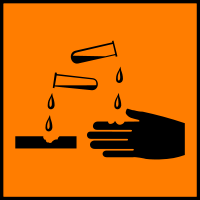|
Storage Condition
|
|
2-8°C, Store Under Nitrogen
|
 Show
data source Show
data source
|
|
|
Storage Warning
|
|
Highly Flammable/Corrosive/Toxic/Moisture Sensitive/Store under Argon
|
 Show
data source Show
data source
|
|
Moisture Sensitive
|
 Show
data source Show
data source
|
|
|
RTECS
|
|
JM9230000
|
 Show
data source Show
data source
|
|
|
European Hazard Symbols
|
 Corrosive (C) Corrosive (C)
|
 Show
data source Show
data source
|
 Flammable (F) Flammable (F)
|
 Show
data source Show
data source
|
|
X
|
 Show
data source Show
data source
|
 Harmful (Xn) Harmful (Xn)
|
 Show
data source Show
data source
|
|
|
UN Number
|
|
2924
|
 Show
data source Show
data source
|
|
2924, 3286
|
 Show
data source Show
data source
|
|
3286
|
 Show
data source Show
data source
|
|
UN2924
|
 Show
data source Show
data source
|
|
|
MSDS Link
|
|
|
German water hazard class
|
|
2
|
 Show
data source Show
data source
|
|
|
Hazard Class
|
|
3
|
 Show
data source Show
data source
|
|
8
|
 Show
data source Show
data source
|
|
|
Packing Group
|
|
2
|
 Show
data source Show
data source
|
|
II
|
 Show
data source Show
data source
|
|
|
Australian Hazchem
|
|
3WE
|
 Show
data source Show
data source
|
|
|
Risk Statements
|
|
11-20/21/22-34
|
 Show
data source Show
data source
|
|
11-20/21/22-34-52/53
|
 Show
data source Show
data source
|
|
R:9-11-22-27
|
 Show
data source Show
data source
|
|
|
Safety Statements
|
|
16-26-33-36/37/39-45-60
|
 Show
data source Show
data source
|
|
16-26-36/37/39-45
|
 Show
data source Show
data source
|
|
16-26-36/37/39-45-61
|
 Show
data source Show
data source
|
|
9-16-26-36/37/39-45
|
 Show
data source Show
data source
|
|
S:16-17-36/37/39-51
|
 Show
data source Show
data source
|
|
|
EU Classification
|
|
FC
|
 Show
data source Show
data source
|
|
|
EU Hazard Identification Number
|
|
8A
|
 Show
data source Show
data source
|
|
|
Emergency Response Guidebook(ERG) Number
|
|
132
|
 Show
data source Show
data source
|
|
|
TSCA Listed
|
|
是
|
 Show
data source Show
data source
|
|
|
GHS Pictograms
|

|
 Show
data source Show
data source
|

|
 Show
data source Show
data source
|

|
 Show
data source Show
data source
|
|
|
GHS Signal Word
|
|
Danger
|
 Show
data source Show
data source
|
|
|
NFPA704
|
|
|
 Show
data source Show
data source
|
|
|
GHS Hazard statements
|
|
H225-H302 + H332-H311-H314-H412
|
 Show
data source Show
data source
|
|
H225-H311-H331-H302-H314-H318
|
 Show
data source Show
data source
|
|
|
GHS Precautionary statements
|
|
P210-P273-P280-P305 + P351 + P338-P310
|
 Show
data source Show
data source
|
|
P210-P303+P361+P353-P305+P351+P338-P361-P405-P501A
|
 Show
data source Show
data source
|
|
|
Personal Protective Equipment
|
|
Faceshields, full-face respirator (US), Gloves, Goggles, multi-purpose combination respirator cartridge (US), type ABEK (EN14387) respirator filter
|
 Show
data source Show
data source
|
|
|
RID/ADR
|
|
UN 3286 3/PG 2
|
 Show
data source Show
data source
|
|
|
Storage Temperature
|
|
2-8°C
|
 Show
data source Show
data source
|
|